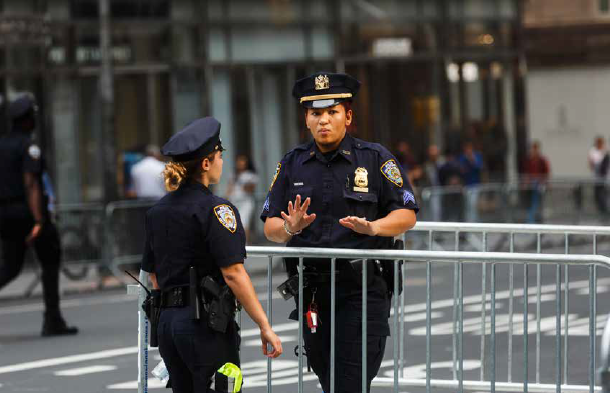Contact Us
To provide feedback on the Community Policing Dispatch, e-mail the editorial board at CPDispatch@usdoj.gov.
To obtain details on COPS Office programs, publications, and resources, contact the COPS Office Response Center at 800-421-6770 or AskCopsRC@usdoj.gov

U.S. Department of Justice
Office of Community Oriented Policing Services
Washington, DC 20530

There is a great deal of research indicating that having female police officers strengthens a department’s ability to build trust in the community and reduces the number of use of force incidents, as well as the complaints or lawsuits that often result.
Realizing this, many departments are eager to recruit more women. Yet today, women account for less than 13 percent of all law enforcement officers and only three percent of leadership.
To increase these numbers, the Policing Project of New York University’s School of Law worked with police leaders and organizations such as NAWLEE (National Association of Women Law Enforcement Executives) to develop the 30X30 Initiative.
Since its launch in March 2021, more than 40 police agencies have signed the 30X30 pledge to recruit classes that are at least 30 percent female by 2030.
But even after signing the pledge with the best intentions, it may not be easy to recruit and retain well qualified women. Here is a sampling of established practices and new ideas suggested by women in the field for attracting women to law enforcement and keeping them on the force.
Adjust physical fitness requirements to focus less on push-ups and more on people skills.
According to the report of the 2018 National Institute of Justice (NIJ) Research Summit on Women in Policing, research shows that certain common hiring and physical fitness requirements disproportionately disadvantage women, without accurately reflecting the actual duties of a law enforcement officer.
Attendees of the summit identified these requirements as a major challenge for women, with one participant wondering if these were deliberate attempts to “wash women out.” One attendee noted that tests for employment were based on upper body strength, thus favoring men, despite a lack of evidence that upper body strength correlated with an applicant’s success as a police officer.
Agreeing with these concerns, Maureen McGough, chief of staff for the Policing Project at NYU Law School and senior policy advisor to the summit, said, “Changes in physical fitness assessments should not lower the standards, but more accurately reflect the physical requirements of the job.”
To address this obstacle, some police departments have developed physical fitness training programs, such as the Indianapolis (Indiana) Metropolitan Police Department’s (IMPD) PAR Pre-Academy Readiness Training, that focus on women as well as men.
In Newark, New Jersey, former Police Chief Ivonne Roman started the Women’s Leadership Academy (WLA), an easily replicable program run by off-duty officers who help female recruits prepare for the rigors of the academy.
In Alberta, Canada, the Edmonton Police Service (EPS) program, Women Run with the Recruiters (RWR), allows applicants to work out with female officers and also meet officers from various EPS units and ranks.
Provide support for families and new mothers.

Police Department
Family leave, fixed rotations, childcare support, and accommodations for nursing mothers can not only be a powerful incentive for retaining women, but for attracting them as well.
Said Kym Craven, NAWLEE Executive Director, “The need for childcare support is an important, ongoing topic at our meetings.”
Some departments have partnered with the YMCA, houses of worship, and other organizations to offer programs at reduced rates, or to house a department-sponsored and -supported program in a municipal building.
Another possibility is working with a local childcare group that allows early drop-offs and late pickups. In the IMPD, recruits are offered contact information for a daycare center near the academy that was started by a former officer and works with police hours.
Non-rotating shifts allow officers to make predictable childcare schedules, and flexibility in scheduling helps all families. According to Chief Vera Bumpers of the Houston (Texas) METRO Police Department, her department gives everybody at least half of the weekend off: two days either on Friday and Saturday or on Sunday and Monday.
A challenge for new mothers is finding a private space for pumping breastmilk. The Akron (Ohio) Police Department converted a vacant office into a room for breastfeeding mothers, complete with a recliner and a refrigerator. In other departments, nursing mothers can use quiet rooms provided for all members of staff.
Design recruitment materials to be more service-oriented and inclusive.
Research indicates that both men and women in today’s recruit generation are more service oriented than in previous generations, and marketing materials should reflect that.
Charleston (South Carolina) Police Department surveyed students in a criminal justice program to evaluate their reactions to tactical versus community service messaging in recruitment materials. They found that the strongest motivator for choosing a career in law enforcement was the chance to make a positive impact on the community.
Featuring women in all recruitment materials is very important. New York State Police changed their recruitment photos, which featured a male officer holding a gun, to a picture of officers holding the tools they work with—which included women officers holding a child or basketball.
Women need to be seen in person as well, not just as members of the recruitment team, but in the community on a regular basis as the face of the department. Speaking engagements at sorority meetings, women’s sports team gatherings, and other women’s groups is recommended by many officers.
Also widely recommended is looking beyond criminal justice programs. Psychology, sociology, political science, and health science students are also likely fields for candidates for law enforcement careers, and recruiting in these departments may reach more women, too.
Support women’s efforts to advance and diversify professionally.
Encouraging female officers to advance through the ranks and supporting their efforts will not only keep more of them on the force, but also make the department more attractive to female recruits.
Women need to see other women in law enforcement who they can identify with—and see them in a variety of roles and ranks. Be sure to publicize all promotions to higher ranks.
Said Captain Valerie Littlejohn of the IMPD, “We post a lot of things on Facebook with female officers from different units—patrol, detectives, homicide, and show our female deputy chief too.”
Said Chief Nora Baston of the Boston (Massachusetts) Police Department, “There is no better recruiting strategy than enabling people to get to know us and see what kinds of things we do.” There are now opportunities in her department for women in canine, drug, gang, truck, and SWAT units.
But though women are more likely to get promoted if they have widespread experience on the force, many are discouraged from it. Said one officer in another department, “Some women are on SWAT or motorcycle, but most are pushed into juvenile services and community outreach, then get locked into it.”
Start a women’s mentoring program.

Having strong role models, advocates, and mentors (both women and men) among law enforcement leaders is important for a female officer, not only to her career track but also to her sense of belonging in the department.
Though male mentors are helpful, some are less able to identify with a woman officer’s personal experiences, particularly those related to navigating a male-dominated culture. However, their perspective can be beneficial to women navigating the leadership structure.
Women in departmental leadership positions should be encouraged to reach out to other women in the department and possibly establish formal mentorship programs. Membership in national professional groups such as NAWLEE and the National Organization of Black Law Enforcement Executives (NOBLE), through which women can find mentors, role models and compatriots as well as support, should also be encouraged.
Recruitment mentors can help candidates with the application process and introduce them to all units and ranks to give them a sense of the diverse jobs and responsibilities within the department.
These are just a sampling of the recommendations made by men and women in the field. For more ideas, insights, and information, please see the following publications:
- Women in Policing: Breaking Barriers and Blazing a Path
- Fit for Duty: The Women’s Leadership Academy
- A Powerful Recruiting Incentive: Child Care Support for Law Enforcement Parents
- CRI-TAC Spotlight: Recruitment and Retention for Workforce Diversity
- Law Enforcement Recruitment in the 21st Century: Forum Proceedings
Faye C. Elkins
Sr. Technical Writer
COPS Office
Subscribe to Email Updates
To sign up for monthly updates or to access your subscriber preferences, please enter your email address in the Subscribe box.






